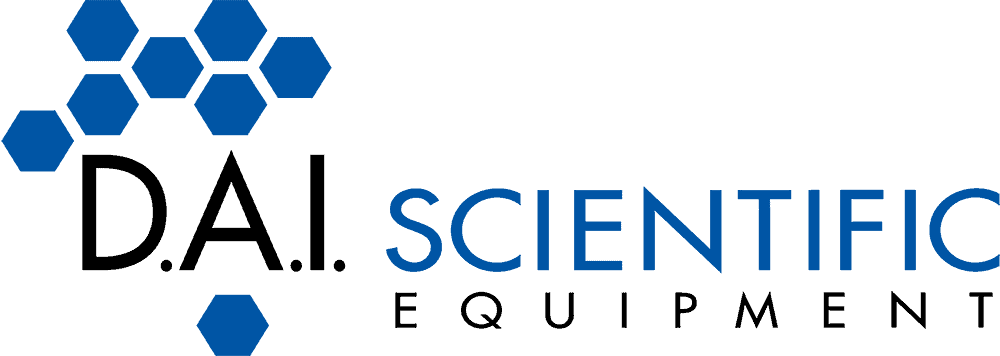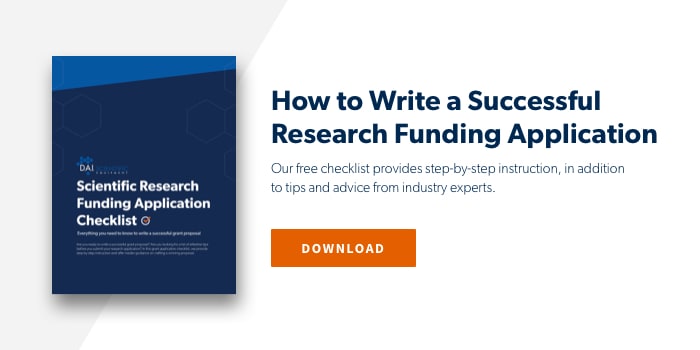Grant funding is critical for all types of research. Without it, many projects wouldn’t even get off the ground, so what’s the key to securing the right funding? The not-so-simple answer: a stellar grant application.
If you’ve ever wondered how to write a successful proposal — or if you’re looking for some new resources and a few refresher tips — we have the right resource for you. In this comprehensive guide, we explore all types of grant funding opportunities, provide a step-by-step proposal breakdown and offer insider tips for ultimate grant application success.
The information in this guide was provided by Mike Hendrickson, Project Manager at BrainXell, Inc; Dr. Shannon M. Lauberth, Associate Professor of Biochemistry and Molecular Genetics at Northwestern University; Dr. Darshan Sapkota, Assistant Professor of Biological Sciences at the University of Texas at Dallas; and Dr. Ward Tucker, Director of Research and Development at BioSentinel, Inc.
Find a Grant: What Opportunities Are Available?
This isn’t a comprehensive list, but these are the most popular types of grant funding opportunities.
National Institutes of Health (NIH)
The National Institutes of Health provides more than $32 billion each year for biomedical research funding. The NIH grants and funding opportunities page publishes opportunities daily and issues a table of contents weekly. You can also subscribe to a weekly email for updates.
National Science Foundation (NSF)
The National Science Foundation funds approximately 25% of all federally supported research in higher education. The NSF is divided into a number of specific research areas, including:
- Biological Sciences
- Computer and Information Science and Engineering
- Education and Human Resources
- Engineering
- Environmental Research and Education
- Geosciences
- Integrative Activities
- International Science and Engineering
- Mathematical and Physical Sciences
- Social, Behavioral and Economic Sciences
You can search for NSF funding opportunities here.
Small Business Innovation Research (SBIR) and Small Business Technology Transfer (STTR)
SBIR and STTR grants are geared toward small U.S. businesses that are looking for funding opportunities in research or research and development “with the potential for commercialization.” Eligible businesses must be for-profit, located in the United States, and more than 50% owned and controlled by one or more U.S. citizens. The company must also have fewer than 500 employees.
Non-Federal Agencies & Foundations
Many grant opportunities are available through non-federal avenues. This is just a sample of some of the agencies and foundations that provide these types of funding opportunities.
- Alliance for Cancer Gene Therapy
- Alzheimer’s Association
- American Federation for Aging Research
- American Heart Association
- American Cancer Society
- American Chemical Society
- American Diabetes Association
- Foundation for Women’s Wellness
- March of Dimes
Early Stage Investigator Awards
An early stage investigator is “a new investigator who has completed his or her terminal research degree or medical residency — whichever date is later — within the past 10 years and has not yet competed successfully for a substantial, competing NIH research grant.”
- American Cancer Society Research Scholar Grants
- Pew Scholar Program
- Sidney Kimmel Foundation
- NIH New & Early Stage Investigator Program
Step-By-Step Grant Proposal & Application Breakdown
Once you’ve found your grant opportunity, it’s time to take action. Here’s what you need to know:
1. Build a timeline.
There are a lot of moving parts in the application process, so the first step is to create a timeline. You want to allow yourself enough time to gather information and write the proposal without feeling rushed. Plus, you need to factor in time for editing and internal reviews. Write down the due date of the application and work backwards. Remember, it’s always best to err on the side of having too much time rather than not enough.
2. Create a robust outline.
This is the most important part of the application process, and the more detail, the better. Be specific in your questions, hypothesis, aims and goals. Detail your experiments and expected outcomes.
3. Gather your appropriate tools and resources.
Before you begin writing, make sure you gather everything in one place. If you need to request certain documents, do so now. Create a folder on your computer that houses everything related to your grant application — and make sure to back up your files if you aren’t using Google or another cloud-based provider. It sounds like a simple reminder, but the last thing you want is to lose all your hard work.
4. Read through the application instructions carefully and don’t be afraid to ask questions. Familiarize yourself with the request, rules and requirements.
Read through everything, noting any documents you need to include. Every document that is requested must be included in the application. And if you have any questions about the process or you’re looking for clarification on a particular item, reach out to the program officer. It’s also better to ask questions as early as possible in the process.
5. Include strong preliminary data.
Even if grant requests say it is not necessary to include any data, you are unlikely to be funded if you don’t include any preliminary data. It is a major piece of any application. The stronger the data, the better shot you have of receiving funding.
6. Write, write, write!
Now it’s time to put pen to paper, so to speak. Here are some important tips to keep in mind during this important process:
- Be realistic: If you’re applying for a Phase 1 grant, it’s important to remember that Phase 1 is supposed to be “proof of concept” — in other words, not product development. Some people try to squeeze five years worth of work into one year, but you need to be realistic. Think carefully, and be modest about your objectives. If you end up applying for a Phase 2 grant, the reviewers will look at your goals and objectives for Phase 1. If you didn’t deliver then, there’s a good chance your Phase 2 proposal will be rejected.
- Tell a story. With any type of good writing, you want to build a case — in other words, tell a story. Start with an introduction that hooks the audience. Talk about the wider problem you’re hoping to explore and why you are the right person for the job. Explain your hypothesis and how you plan to tackle it.
- Include two or three specific aims. This is the heart of the grant. Again, be reasonable. Don’t bite off more than you can chew in order to seem overly ambitious. Include two or three challenging yet exciting aims (or goals) that you believe are doable in the set amount of time. Include clear objectives and clear milestones of success.
- Be mindful of your language. Be specific, informative and engaging but also concise. Use active voice and strong verbs like “determine and distinguish.” Quantify information or data.
- Don’t get too technical or use too much jargon. Remember, you know your field inside and out, but your reviewers in some cases may not. Make your application clear and readable. Write for an educated but diverse audience.
- Include preliminary data. It’s important, so it bears repeating!
- Add pictures, illustrations or graphics. No one wants to read a 15-page proposal of extremely dense text. Break up your application with a few visuals.
7. Make sure the budget matches what is allocated.
It sounds obvious, but don’t ask for more than the set budget amount. If you work at a higher education institution, you will likely work with a research office on the budget.
8. Have multiple people review your application.
Once you’ve written your grant proposal (congratulations!), you want to seek out multiple reviewers before you click submit. These reviewers should be inside your company, organization or institution, or experts in your field; you may also benefit from review by non-experts. It’s important to give your reviewers plenty of time, too. Here are some good questions to ask:
- Is the proposal clear and concise?
- Do I need more data?
- Are any parts confusing or in need of additional explanation?
- Am I telling an interesting story?
- Could I add any other visuals?
9. Give yourself enough time to familiarize yourself with the application portal — and then submit!
If you work with a research office, they will upload the application on your behalf. If you don’t, you want to make sure you familiarize yourself with the application portal before your deadline.
Insider Tips for Grant Writing Experience & Creating a Standout Application
We spoke to the experts, and here’s what they had to say:
- Talk to the program officers early and often. There are people who don’t put the time and energy into reviewing the instructions, rules and requirements of a grant application. Make sure you understand everything, and if you don’t, talk to the program officers. Remember — you don’t have to figure out everything by yourself!
- Don’t break the rules. If the application requires certain documents, make sure to include them.
- Don’t be “non-responsive.” This is grant proposal-speak for not answering a question that is asked of you. Reviewers will take note.
- Put yourself in the shoes of a reviewer. What questions will the reviewers have, and how can you answer them ahead of time? Ideally you want to address these questions with preliminary data. If you don’t have the data, it’s important to at least address those questions in your proposal — and how you plan to tackle them.
- Don’t save everything until the last minute. There’s a very good chance you heard this mantra in high school and college — and it still rings true.
- Consider hiring someone who can handle the grant application process. If you have the budget, it may be valuable to hire a person who can handle the administrative and logistical aspects of the application process. Some companies and organizations also hire part-time or full-time grant writers to handle the actual proposal writing.
- Explore all types of funding opportunities. In addition to traditional federal agencies like NIH and NSF that routinely offer grants, you should explore any internal funding opportunities for faculty and researchers. Sign up for as many email lists, newsletters and daily grant alert notifications from federal and non-federal agencies as possible. If you work in an academic setting, ask your department chair about these opportunities.
- Simultaneous submissions are allowed. It’s just illegal to accept funding from two different institutions for the same work.
-
Ask to help out on a grant application. Grant writing is a skill that is honed with time and experience, and the best way to get better is to practice. Review applications that your colleagues have been working on or ask them if you can help out in any way. Practice makes perfect.
- The Grant Application Writer’s Workbook: It’s one of the best tools and a resource you’ll return to again and again.
- Ask to participate in a review committee. This will give you the opportunity to see grant applications from a different perspective, which will be beneficial in your own funding quests.
- Attend grant writing workshops. This is another important way to gain insight and experience.
- Remember the big picture. As Shannon Lauberth, associate professor at Northwestern University, explains: “Remember that the exercise of writing a grant helps you to carve out clear directions for your lab.”
Grant Application Resources
This is not an exhaustive list, but here are some helpful tools and resources you may want to explore or bookmark:
- Fundamentals of the NIH Grant Process & Need to Know Resources [VIDEO]
- The Grant Application Writer’s Workbook
- NIH Grants Process Overview
- NSF Funding Search
- NIH Guide for Grants and Contracts
- SMARTS — Email alert system about funding opportunities
Specific Questions About Lab Equipment?
D.A.I. Scientific works closely with a variety of federally funded organizations, private businesses and higher education institutions to provide products and services to analytical laboratories in the pharmaceutical, educational, biotechnology and clinical industries. If you’re writing a grant application and need a budgetary quote for equipment, contact us today. Our knowledgeable experts would be happy to help.




